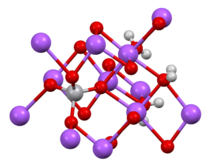Sodium orthovanadate

| |
| Names | |
|---|---|
| IUPAC name
Sodium vanadate(V)
| |
| Other names
Sodium vanadium oxide
| |
| Identifiers | |
| |
3D model (
JSmol ) |
|
| ChEBI | |
| ChEMBL | |
ECHA InfoCard
|
100.033.883 |
PubChem CID
|
|
RTECS number
|
|
| UNII | |
CompTox Dashboard (EPA)
|
|
| |
| |
| Properties | |
| Na3VO4 | |
| Molar mass | 183.908 g/mol |
| Appearance | white powder |
| Density | 2.16 g/cm3, solid |
| Melting point | 858 °C (1,576 °F; 1,131 K) |
| 22.17 g/100 mL | |
| Solubility | insoluble in ethanol |
| Structure | |
| cubic | |
| Thermochemistry | |
Heat capacity (C)
|
164.8 J/mol K |
Std molar
entropy (S⦵298) |
190 J/mol K |
Std enthalpy of (ΔfH⦵298)formation |
−1757 kJ/mol |
| Hazards | |
| Occupational safety and health (OHS/OSH): | |
Main hazards
|
Harmful. |
| NFPA 704 (fire diamond) | |
| Flash point | Non-flammable |
| Lethal dose or concentration (LD, LC): | |
LD50 (median dose)
|
330 mg/kg (oral, rat) |
Except where otherwise noted, data are given for materials in their standard state (at 25 °C [77 °F], 100 kPa).
| |
Sodium orthovanadate is the inorganic compound with the chemical formula Na3V O4. It forms a dihydrate Na3VO4·2H2O. Sodium orthovanadate is a salt of the VO3−4 oxyanion. It is a colorless, water-soluble solid.[2]
Synthesis and structure
Sodium orthovanadate is produced by dissolving vanadium(V) oxide in a solution of sodium hydroxide:
- V2O5 + 6 NaOH → 2 Na3VO4 + 3 H2O
The salt features tetrahedral VO3−4 anion centers linked to octahedral Na+ cation sites.[3]
Condensation equilibria
Like many oxometalates, orthovanadate is subject to a number of reactions, which have been analyzed by
Biochemistry
Vanadates exhibit a variety of biological activities, in part because they serve as structural mimics of phosphates.[6][7] It acts as a competitive inhibitor of ATPases, alkaline and acid phosphatases, and protein-phosphotyrosine phosphatases,[8] and its inhibitory effects can be reversed by dilution or the addition of ethylenediaminetetraacetic acid (EDTA).[9]
Orthovanadate is activated by boiling and adjusting pH to ~10; this depolymerizes
References
- ^ "Archived copy". Archived from the original on 2016-03-04. Retrieved 2017-09-28.
{{cite web}}: CS1 maint: archived copy as title (link) - ISBN 978-0-08-037941-8.
- .
- ISBN 9780123739193.
- .
- PMID 22693688.
- ISBN 978-0-08-097774-4.
- ^ a b "Sodium orthovanadate" (PDF). Sigma-Aldrich. Retrieved September 7, 2018.
- ^ Biolabs, New England. "Sodium Orthovanadate (Vanadate) | NEB". www.neb.com. Retrieved 2018-09-07.

